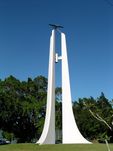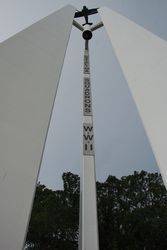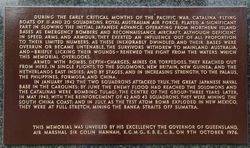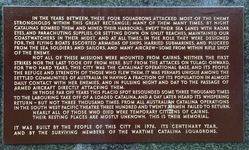
Home » Themes » Conflict » World War Two
Catalina MemorialPrint Page 
The monument was erected by the people of Cairns and surviving members of the Catalina Squadrons to commemorate the 320 airmen who failed to return while flying Catalinas in the South West Pacific campaigns during World War Two. Further plaques were added to the memorial in 1993.
The Catalina was designed in the 1930s as a long-range reconnaissance flying boat. The Royal Australian Air Force (R.A.A.F.) used them not just for reconnaissance and rescue, but also as bombers in the war against the Japanese. The Catalina`s had the highest loss rate of any R.A.A.F. aircraft in the south-west Pacific area. The Catalinas operated out of Cairns during World War Two.
The exploits of the Catalina Squadron during World War 2 have been honored by the construction of a spectacular memorial on the seafront at Cairns. The citizens of Cairns and ex-members of Catalina Squadrons throughout Australia have combined to produce a memorial that must be one of the most impressive in Australia. Ex-Catalina crews, including Air Vice Marshall P. S. Robey, A.O., C.B.E., M.I.D., Air Officer commanding Operational Command, Penrith, New South Wales, all returned to Cairns for the unveiling on Saturday, October 9.
Cairns was Australia's most important Catalina base during World War 2. Catalinas from Cairns struck enemy targets as far north as China. The City of Cairns, which undertook the project as one of its Centenary year activities, has received the full support of the RAAF. Catalina operations during World War 2 were top secret activities and the true story of the Catalinas has never been told before.
The RAAF have produced a pamphlet releasing many of their details, to honor the construction of the unique memorial. The RAAF presented the City of Cairns with an oil painting of one of the famous "cats". They also provided an Honor Guard, three Padres and a fly-past of aircraft, for the unveiling. The Governor of Queensland, Air Marshal, Sir Colin Hannah, K.C.M.G., K.B.E., C.B., unveiled the 19m high memorial. The Memorial consists of three sweeping fins symbolic of the tail fins of the Catalinas. Set on a metre high earth mound, it contains a brass plaque containing the story of the "cats"
Papua New Guinea Post-Courier (Port Moresby), 15 October 1976.
Location
| Address: | Abbott Street, Cairns, 4870 |
|---|---|
| State: | QLD |
| Area: | AUS |
| GPS Coordinates: | Lat: -16.913447 Long: 145.770323 Note: GPS Coordinates are approximate. |
Details
| Monument Type: | Monument |
|---|---|
| Monument Theme: | Conflict |
| Sub-Theme: | WW2 |
| Actual Event Start Date: | 03-September-1939 |
| Actual Event End Date: | 15-August-1945 |
| Link: | http://www.qldwarmemorials.com.au |
Dedication
| Actual Monument Dedication Date: | Saturday 9th October, 1976 |
|---|
During the early critical months of the Pacific War, Cataling Flying Boats of 11 and 20 Squadrons, Royal Australian Air Force, played a significant part in slowing the initial Japanese advance. Operating from northern island bases as emergency bombers and reconnaissance aircraft, althought deficient in speed, arms, and armour, they exerted an influence out of all proportion to their limited numbers. As these inexorably dwindled, and their bases were overrun or became untenable, the survivors withdrew to mainland Australia and - briefly licking their wounds - renewed the fight from the waters which this memorial overlooks.
Armed with bombs, depth-charges, mines of torpedoes, they reached out from here, in single flights, to the Solomons, New Britain, New Guinea, and the Netherlands East Indies ; and by stages, and in increasing strength, to the Palaus, the Philippines, Formosa and China.
In January 1942 the two Squadrons attacked Truk, the great Japanese naval base in the Carolines ; by June the enemy flood had reached the Solomons and the Catalinas were bombing Tulagi, the centre of the group: Three years later in May 1945, with the reinforcement of 42 and 43 Squadrons, they were mining the South China Coast ; and in July, as the test atom bomb exploded in New Mexico they were at full strength, mining the Banka Straits off Sumatra.
The memorial was unveiled by His Excellency the Governor of Queensland , Air Marshal Sir Colin Hannah, K.C.M.G., K.B.E., C.B., on 9th October 1976.
In the years between, these four Squadrons attacked most of the enemy strongholds within this great rectangle ; many of them many times. By night Catalinas bombed them, and mined their harbours ; swept their sea lanes with radar eyes, and parachuting supplies, or setting down on unlit reaches, maintained our coastwatchers in their midst. And at all times, in the role they were designed for, the flying boats escorted armadas of ships, harried submarines, and plucked from the sea soldiers and sailors, and many aircrew - some from within rifle shot of the enemy.
Not all these missions were mounted from Cairns. Neither the first strikes not the last took off from here, but from the attacks on Tulagi onward, for two hard years, this city was the Catalina`s operational base, and its people the refuge and strength of those who flew them. It was perhaps unique among the settled communities of Australia in having a fraction of its population in almost daily contact with her enemies, and in pulsing night and day to the passage of armed aircraft directly attacking them.
In those far off years this placid spot resounded some three thousand times to the labouring take off of a loaded Catalin, and a day later heard its whispering return - but not three thousand times. From all Australian Catalina operations in the South West Pacific theatre three hundred and twenty airmen failed to return. Nearly all of those who died were temporary citizens of Cairns. Their resting places are mostly unknown. This is their memorial.
It was built by the people of this city in 1976, its centenary year, and by surviving members of the wartime Catalina Squadrons.










